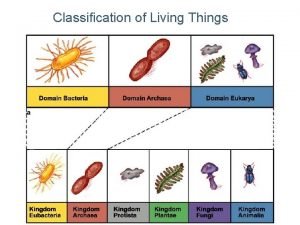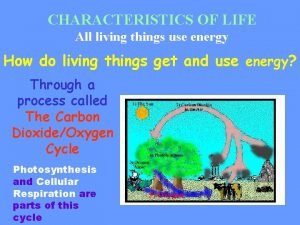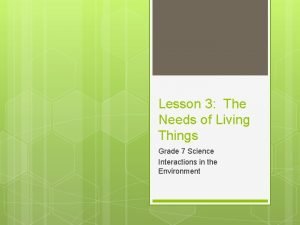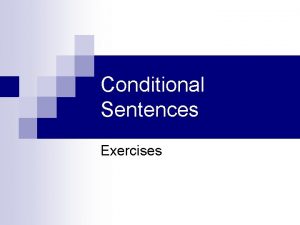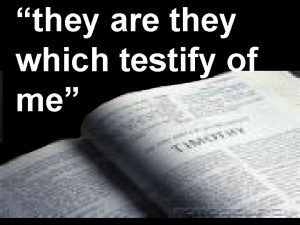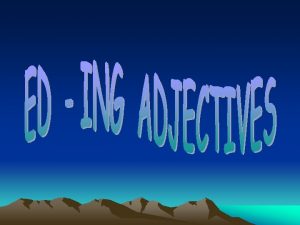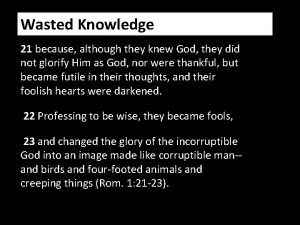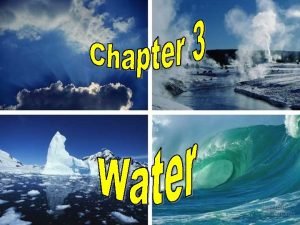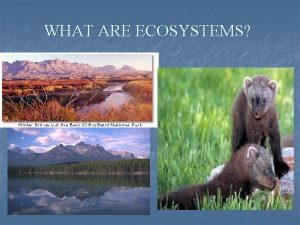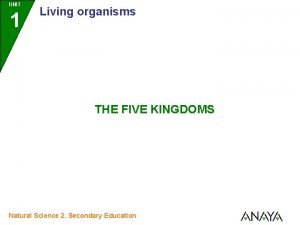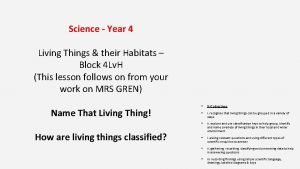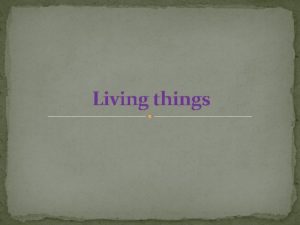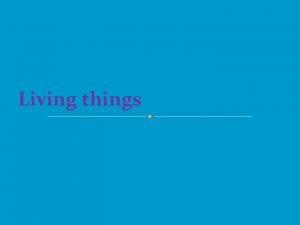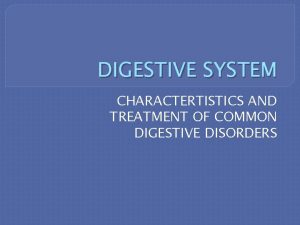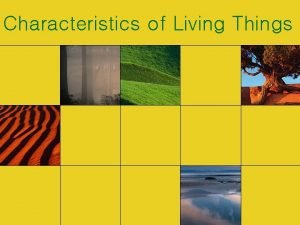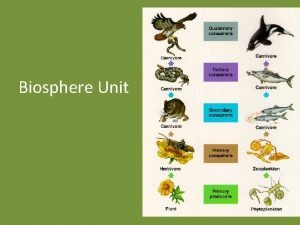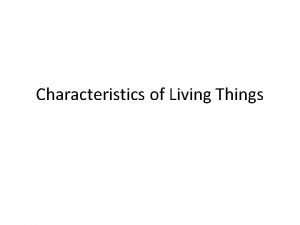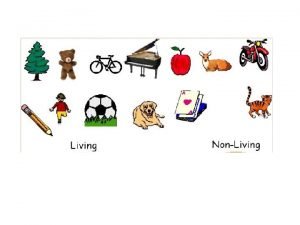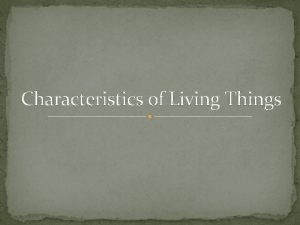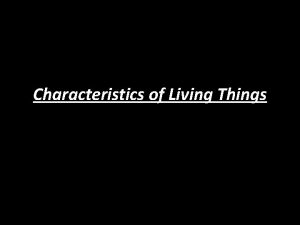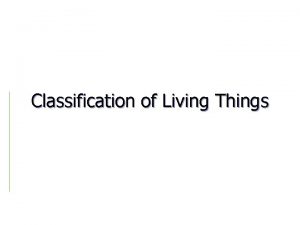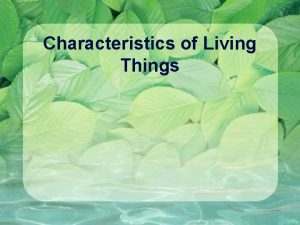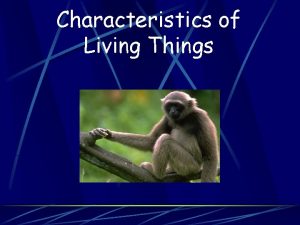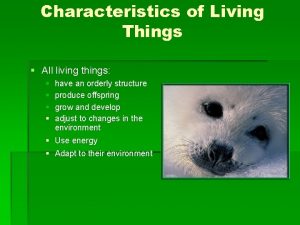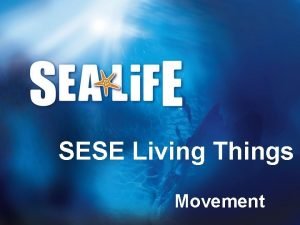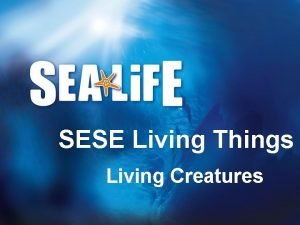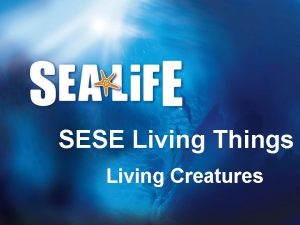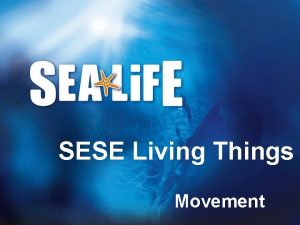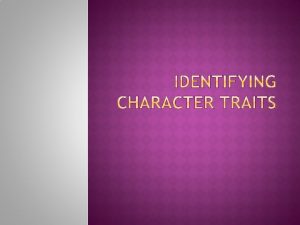Living things Charactertistics of living things They all



























- Slides: 27

Living things

Charactertistics of living things �They all perform the three vital functions (reproduction, nutrition and interaction) �They all are made up of cells. �They all are composed by similar substances


The three vital functions �Nutrition: it is the function by wich living beings obtein matter and energy. �Organisms can perform nutrition in different ways: 1. Heterotrophic nutrition: living beings obtein their food from other living beings. Animals, Fungi, some Protoktists. 2. Autotrophic nutrition: Organisms obtein the food from inorganic substances, CO 2 from the air, minerals from the soil and water using the energy of the Sun. Plants, some Bacteria and some Protoktists.

Nutrition

The three vital functions �Interaction: Whit this function, organisms obtain information about the environment and react by producing a response. �Living beings reacts to stimuli like: light, sound, pressure, temperature, humidity, other organisms. Responses: movement, production of chemical substances, etc.

Interaction

The three vital functions �Reproduction: �This functions allows living beings to produce new individuals. �Types: 1. Asexual: the organism produces copies of itself. 2. Sexual: Two parents are needed to produce descendents that share the genetic characteristics of them. Animals lay eggs or give birth to live young, plants produce seeds, bacteria divide into two copies.

Reproduction

What are living things made up of? �All living things are made up of chemical substance´. The most common elements in living matter are: C, H, O, N , P and S. Combinations of these elementes form molecules called biomolecules. 1. Organic biomolecules 2. Inorganic biomolecules

Biomolecules Inorganic (do not contain Carbon) Organic: contain Carbon �Water (H 2 O): chemical �Carbohydrates (energy reactions, it transports substances. �Mineral salts : make structures, balance internal fluids and structure) �Lipids (energy and structure) �Proteins (structures, to fight deseases, to transport O) �Nucleic acids (to carry genetic material)

Cells (CELL THEORY) �Cells are the smallest unit of life. (functional and structural) 1. All living things are made up of one or more cells. 2. Cells carry out the 3 vital functions. 3. All cells come from other cells.

BASIC TYPES OF CELLS PROKARYOTIC EUKARYOTIC

Prokaryotic cells �They have no nucleus. Genetic material is dispersed throughout the cytoplasm. They don’t have organelles. �Bacteria are made up of prokaryotic cells.

Eukaryotic cells �Tfrom they have a nucleus that contein the genetic material and it’s separated from the cytoplasm by a membrane. �They contain organelles (mitochondria, vacuoles, chloroplasts, …) �Algae, Protozoa, Fungi, Plants and Animals have eukaryotic cells.

Eukariotic cells Animal cell Plant cell

Differences Animal cell Plant cell Plasmatic Membrane Cell wall Various shapes Polyhedral NO chloroplasts Chloroplasts Small vacuoles Big and unique vacuole

Structure of a eukaryotic cell �Cell membrane: controls what passes in and out �Nucleus: contains genetic material �Cytoplasm: contains the organelles and holds them �Mitochondrium: obteins energy from nutrients by cell respiration �Vacuoles: Store substances, mainly water �Cell wall: thick and rigid it manteins the shape �Chloroplasts: contain chlorophyll wich absorbes the Sun’s energy to produce glucose during photosynthesis.

Classification of living things � Attending to the number of cells: Unicellular organisms: have only one cell. They sometimes form colonies. 2. Multicellular organisms: They have many different cells. Cells are organised in levels. The cells work together to carry out the vital functions. 1.

Levels �Cells: specialised, they have specific functions (and shape) �Tissues: groups of cells with the same function and origin and sometimes structure. �Organs: groups of tissues wich act together. �Systems: groups of organs.

Now guess the level!!

Guess the level!!


The 5 kingdoms

The Kingdoms 1. 2. 3. 4. 5. Monera- Bacteria and Cyanobacteria (Prokaryotic)Unicellular –Autotrophic or heterotrophic. Protoctist – Protozoa and Algae -Unicelullar and multicellular- No tissues – Autotrophic and heterotrophic Fungi: Yeasts, Moulds, Mushrooms – unicellular and multicellular –No tissues –heterotrophic Plant. Mosses, Ferns, Flowering plants – multicellular – tissues – autotrophic Animals: vertebrate and invertebrates- multicellular –tissues - heterotrophic

Classification �Kingdom �Phyllum (it may have sub phyllum) �Class �Order �Family �Genus �Species (it may have subspecies)

What is a species? �It is a set of living beings which are physically similar, they reproduce and have fertile descendents. �Human being: Homo sapiens �Wolf: Canis lupus �Dog: Canis familiaris �Donkeys: Equus asinus �Horse: Equus caballus
 The smallest living unit of all living things is
The smallest living unit of all living things is All living things have seven life processes
All living things have seven life processes Pyramid hesd
Pyramid hesd 8 levels of classification
8 levels of classification Cell to tissue to organ to organ system to organism
Cell to tissue to organ to organ system to organism Life cycle of all living things
Life cycle of all living things What are the 5 basic needs of all living things
What are the 5 basic needs of all living things Different types of living organisms
Different types of living organisms Throwaway living
Throwaway living Name all the lines name all the segments name all the rays
Name all the lines name all the segments name all the rays Is a seed living or nonliving
Is a seed living or nonliving Living non living dead
Living non living dead Text derek
Text derek Rankings: what are they and do they matter?
Rankings: what are they and do they matter? If they have time in the weekend they will come to see us
If they have time in the weekend they will come to see us They seek him here they seek him there
They seek him here they seek him there Samuel they have rejected me
Samuel they have rejected me Jordan 14
Jordan 14 Grammar rules frustrate me they're not logical they are so
Grammar rules frustrate me they're not logical they are so For they not know what they do
For they not know what they do Knowledge not shared is wasted
Knowledge not shared is wasted Why is water important to living things
Why is water important to living things Non living things in freshwater
Non living things in freshwater Kingdoms of living things
Kingdoms of living things Living things grow
Living things grow Living things meaning
Living things meaning Ecosystem living and nonliving things
Ecosystem living and nonliving things Organic compounds made by living things
Organic compounds made by living things



